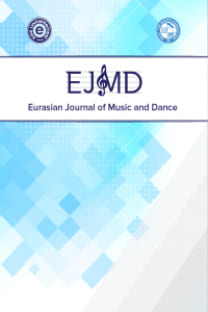M. RAVEL ALBORADA DEL GRACIOSO’NUN FORM ve PİYANO TEKNİĞİ AÇISINDAN İNCELENMESİ
Bir müzik eserini iyi icra edebilmek için; bestecinin yaşadığı dönemin, coğrafyanın, doğduğu yerin, etkilendiği akımların veya bestecilerin, müzik dilinin (stilinin) incelenmesinin yanı sıra eserin teknik, form ve müzikal açılardan da iyi analiz edilmesi oldukça önemlidir. Bundan dolayı bir eseri enstrüman ile çalışmaya başlamadan önce bu araştırmayı yapmak mutlaka tavsiye edilir. İcracının yapacağı bu araştırma çalacağı eseri daha çok benimsemesine ve bestecinin duygularını, isteklerini daha iyi anlamasına yardımcı olacaktır. Fransız empresyonist (izlenimci) besteci Maurice Ravel’in (1875-1937) piyano eseri Miroirs (aynalar) beş bölümden oluşur ve her bölüm bestecinin zihnindeki düşüncelerin veya resimlerin yansımasını ifade eder. Bu bağlamda eser empresyonist müziğin en önemli örneklerindendir. Çalışmaya konu olan parça Alborada del Gracioso Miroirs serisinde dördüncü sıradadır ve piyano tekniği açısından bakıldığında dinamik yapısıyla içlerinde en zor olanıdır. İspanyol Flamenko müziği unsurları barındıran parça aynı zamanda piyanistler arasında da en çok bilinen ve çalınanıdır. Bu nedenlerle araştırmada Alborada del Gracioso’yu çalacak piyanistlere eseri çalışma öncesinde veya çalışma sırasında başvurabilecekleri kapsamlı bir kaynak ortaya çıkarmak hedeflenmiştir. Parçanın form ve piyano tekniği açısından analizi yapılmış olup, piyanistlere kolaylaştırıcı bazı tavsiyelerde bulunulmuştur.
Analysis of M. Ravel’s Alborada Del Gracioso in Terms of Form and Piano Technique
In order to perform a musical work effectively, one must explore the period and the country in which the composer was born and lived, the schools of music and composers that inspired him along with his musical style and also analyze the musical work in terms of technique, form and musical structure. For this reason, it is strongly recommended that this study be carried out before a musical work is played with an instrument. Such an analysis enables the performer both to identify with the musical work and have a better grasp of the composer’s feelings and desires. Miroirs, a piano piece by the French impressionist M. Ravel (1875-1937), is composed of five sections, each of which expresses the reflection of the ideas and images constructed on the composer’s mind. In this context, the piece is among the most important examples of the impressionistic music. Alborada del Gracioso, the focus of this research, ranks fourth in the Miroirs series and it is the most difficult one in terms of piano technique. Harbouring elements of Spanish Flamenco music, this piece is the most well-known as well as the most played among pianists. For all these reasons, we aim to provide those pianists willing to perform this piece with a comprehensive guide to which they can resort both before and during the performance. This study analyzes the piece from such different perspectives as form and piano technique, while at the same time offering some useful recommendations to the pianists.
___
- Abramovitch, R. (2012). Maurice Ravel’s Miroirs for Piano: Historical background and some performance related aspects (Yayımlanmış Doktora Tezi, Indiana Üniversitesi, Indianapolis).
- Aktüze, İ. (2003). Müziği okumak. İstanbul: Pan Yayıncılık.
- Howat, R. (2009). The art of French piano music. North Yorkshire: Yale University Press.
- Ko, E. (2007). Music and image: A performer’s guide to Maurice Ravel’s Miroirs (Yayımlanmış Doktora Tezi, Cincinnati Üniversitesi, Cincinnati).
- Murdoch, H.M. (2007). Ravel’s Miroirs: Text and context (Yayımlanmış Yüksek Lisans Tezi, Witwatersrand Üniversitesi, Johannesburg).
Nichols, R. (1977). Ravel. London: Faber.
- Roland-Manuel, C. (1947). Maurice Ravel. London: Dobson.
- Sadie, S. (1980). The new Grove dictionary of music and musicians. London: Macmillan Publishers.
